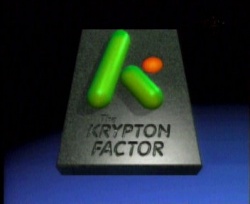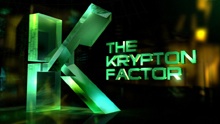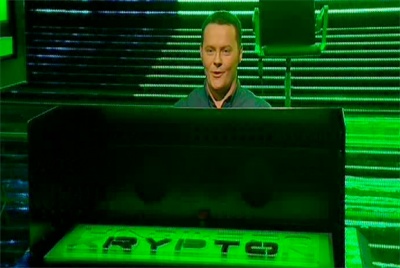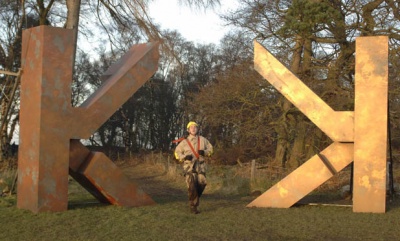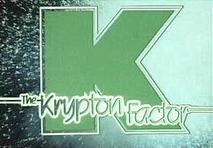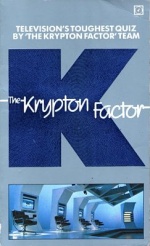The Krypton Factor
| Line 100: | Line 100: | ||
<div class="image">[[Image:Krypton factor 09 intelligence 1.jpg|400px]]''The intelligence round, and those stripes''</div> | <div class="image">[[Image:Krypton factor 09 intelligence 1.jpg|400px]]''The intelligence round, and those stripes''</div> | ||
| - | The assault course is now a Go Ape-style course, which is, rather bizarrely, designed for two people, not four, which means a lot of cutting between two races. The first episode suffered from truly abysmal editing in the Physical Ability round, destroying any sense of how the contestants were progressing. The second episode was much better and hopefully the initial problems are behind us now, though there remain certain fundamental problems - like the assault course being surrounded by trees, making an overview of the course impossible, and that intractable two-race problem. Editing won't fix those issues, though a change of course for the next series might. In the Grand Final, the contestants all competed individually rather than in twos, so they did not know until the recording proper whether they had come first, second, third or fourth. | + | The assault course is now a Go Ape-style course, which is, rather bizarrely, designed for two people, not four, which means a lot of cutting between two races. The first episode suffered from truly abysmal editing in the Physical Ability round, destroying any sense of how the contestants were progressing. The second episode was much better and hopefully the initial problems are behind us now, though there remain certain fundamental problems - like the assault course being surrounded by trees, making an overview of the course impossible, and that intractable two-race problem. Editing won't fix those issues, though a change of course for the next series might. In the Grand Final, the contestants all competed individually rather than in twos, so they did not know until the recording proper whether they had come first, second, third or fourth. It's not certain whether it was really necessary to do it that way, but it was at least different, if nothing else! |
<div class="image">[[Image:Krypton factor 09 finish line.jpg|400px]]''No tape at the finish line anymore, just these giant Ks.''</div> | <div class="image">[[Image:Krypton factor 09 finish line.jpg|400px]]''No tape at the finish line anymore, just these giant Ks.''</div> | ||
Revision as of 21:51, 9 September 2009
Contents |
Host
Gordon Burns (1977-95)
Ben Shephard (2009-)
Children's version (Young Krypton, 1988-9) hosted by Ross King.
Co-hosts
Penny Smith (1995)
Announcer: Charles Foster (1982-5, 1991-5)
Broadcast
Granada for ITV, 7th September 1977 to 20th November 1995
Granada (as ITV Productions) for ITV1, 1 January 2009-
Synopsis
Properly challenging, immensely popular and fondly remembered game show which combined quiz, puzzle, and physical challenges. Indeed, so successful was it that a revival was probably inevitable, though it was a long time coming. We'll get to the 21st century version in due course, but first let's concentrate on the classic version, in which legendary hell-raiser Gordon Burns put four contestants through "the ultimate mental and physical tests" to find out who was the UK Superperson of whichever year - and there were 18 series!
Whilst the structure of the rounds was tinkered with over the years, the main rounds were (mostly in the following strict order - but not in the 1988 series, in which the order went: Mental Agility; Response; Intelligence; Observation; Physical Ability; General Knowledge):
Mental Agility: Each contestant was given 40 seconds to answer as many questions correct as they could. What they'd have to do changed from week to week. For example, they may have to remember a certain layout of dice, in which case questions would be like "What's on the opposite side of dice which is two to the right of the Red 2". Or they'd be given a sentence and asked questions on it. You can guess the sort of thing. When the show first started it was some strange computer maze thing. In between, it was an elimination contest where the questions got harder and the points were decided by how long you stayed in the game. This was not played against the clock, strangely.
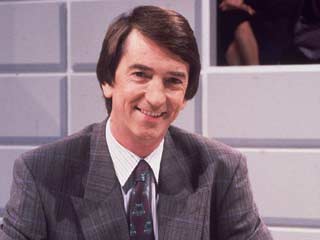 Host of the Krypton Factor, Gordon Burns
Host of the Krypton Factor, Gordon BurnsThe very first series didn't have the "Mental Agility" round, but did include a "Personality" round in which the contestants were set creative tasks such as re-writing nursery rhymes as news reports or inventing limericks on a given topic, with the winner decided by having unfortunate members of the public being surveyed on whose efforts they thought were the best.
Response: This round first started in 1986. In that year's series, this consisted of the contestants competing in twos to move some cylinders from one side to another, then placing some shapes into the correct slots (Fleischmann Flexibility Tests) and finally hitting one of four coloured buttons when the corresponding colour flashed up on a screen, up to a total of 10 correct responses. The contestant with the fastest time would be the winner. In the 1987 series, two tests alternated. In one, there was a race between the contestants to crank a handbike backwards, and some feet pedals forwards, in order to power an electric motor and propel themselves along. If and when they reached the end there was a bank of screens which would flash up different colours and the contestants had to input which colour had the most. The first one to get 10 correct won.
In the other test, balance-beams linked the Fleischmann Flexibility Tests from the previous year, twisting around and fitting shapes into the correct slots. In both of these series, for the group and grand finals, it changed so that the contestants would each take part in a British Aerospace flight simulator and try to land a plane.
From the 1988 series onwards, the Response Test consisted purely of flight simulator tests: these included a Sea Harrier Jump Jet in the 1988 group finals, a Royal Navy helicopter in the 1988 Grand Final and all the later group finals and something special like the Space Shuttle or even a real plane in the Grand Final. They'd be marked by the instructor. This version of the round was arguably better than the 1986/7 one, since the Fleischmann Flexibility and handbike tests, although very entertaining to watch (and possibly to do as well!) did not seem very consistent or comparable with the flight simulator tests.
The flight simulator tests often proved very entertaining, with some contestants crashing the plane, landing it in the sea by Hong Kong Airport or in Lake Tahoe and even flying up instead of down, resulting in a stall! However, there were also plenty of contestants who managed to land well, sometimes even perfectly. The real plane that the 1992 and 1993 Grand Finallists had to land was dual-controlled - not surprisingly! - but the contestants' standard of performance in both those tests was fairly high.
In the 1988 series, a trophy in the form of a Boeing 747 was awarded for whoever had performed best in the first-round Response tests, landing that particular plane in the simulator. This was won by Yvonne Thewlis. It was a shame that this award was only given in that one series: it was a nice touch and should have been kept in.
Observation: In the early series (up until 1985), this involved the contestants watching a drama sketch and then answering questions on it, at first individually and then on the buzzers. This would be followed by an 'Identity Parade', in which 10 or so people looking like one character from the sketch would line up and the contestants had to decide which one was the real character. In some series (1986-88), the round was "Double Take" - i.e. spot the difference between the same film shown twice. Then, in 1989, it changed into the great fun "Spot the Continuity Errors". These pieces of film often starred celebs of their day such as Steve Coogan (a relative unknown back then), Andrew O'Connor and Hinge and Bracket. One of the first films was a skit involving Kenneth and Annie from Treasure Hunt:
From 1990, the Observation round turned into mini-serials. First, it was Sam Smith: Private Detective with Gwyneth Strong (aka Cassandra off of Only Fools...). In 1991, Tony Robinson was the hapless bank manager aided by Michelle Collins in heist drama Where is Don Day? In 1992, mistaken identity caper Dead Ringer starred Tony Slattery, Roger Lloyd Pack, Katie Puckrik (pre-Sunday Show) and Linda Lusardi. A two-minute section would be played each week. 1993 saw a return to two-minute single dramas, with Fred Pilkington (Roy Barraclough) recalling his greatest detective moments to Julie Webb (Annabel Giles). By 1995, the drama had been replaced by computer generated images. In the early days (up to and including 1990), contestants wrote down their answers but it later changed into a multiple choice vote-on-keypads question thing so that ties could be decided on time. Dare we suggest, though, that this was largely for the audience since we're sure the contestants would be quicker to answer than was shown on screen. For Double Take, interestingly, contestants scored a straight two points for each correct answer rather than the usual scoring system.
Physical Ability: Gordon Burns cited this as the reason why he nicknamed Krypton Factor as 'Television's Toughest Quiz'. The contestants raced over the 400m Army assault course at Holcombe Moore, Bury, Lancashire. Originally, each contestant was given a staggered start based on their age and sex. Later, age was discounted and all the female contestants were given a head start with the men chasing them. Noted for the death-slide bit near the end where everyone would get extremely wet going into the water.
Apparently, the course was so dangerous up to eight stand-by contestants were on call in case anything went wrong. When Gordon Burns tried it for himself for the experience, it took him over five minutes to complete (more than twice the usual time) and he ended up with minor injuries.
Intelligence: Apparently "the test many contestants have sleepness nights over", this was a 2D or 3D spatial awareness test where the contestants would be asked to construct something using the pieces given. Invariably there would only be one correct answer and Mr Burns provides a "ha, that's not quite right" commentary using a sportsman's voiceover microphone.
Up until now, points were dished out 10, 6 (8 in earlier series), 4 and 2 for 1st, 2nd, 3rd and 4th but this changes for...
General Knowledge: The final round. Depending on the series, this was 100/90/75 seconds of quickfire questions on the buzzer with two points for a correct answer and two points deducted for a wrong one (one point in earlier series). The questions were set up so that the answer to one question would form a phonetic link with the next question, so particularly clever players may be able to work out where the question was headed. One problem with this round was that, all too often, a contestant who was considerably behind could win if he/she was exceptionally good at general knowledge, and this always seemed unfair on those contestants who had shown more all-round abilities throughout the show, only to be pipped at the last minute if their general knowledge was not so good. This was especially true once the 2-point rule was introduced in 1988. In the 2009 series, there were 70 seconds' worth of questions, still with 2 points for a correct answer, but with only 1 point deducted for a wrong answer. Very few, if any, contestants won from behind during this series, probably because Ben Shephard did not get through quite so many questions as Gordon Burns used to - and also, more thinking-time was allowed if none of the contestants buzzed in - Burns used to give the answer after only 2 or 3 seconds if the contestants failed to answer in the original version.
Up to and including the 1985 series, the buzzer round had been preceded by Burns asking each contestant in turn two or three general knowledge questions. Incorrect answers did not lose the contestants points in this case, nor were the questions offered to their opponents.
Before each round there'd be a lovely little introduction where the Krypton K would turn into a person or a pair of eyes or something that represents the round about to be played. This lasted from 1986 until 1993 and has been revived (well, sort of!) in the 2009 series.
All change, please
For the final series, the show decided it wanted to be The Crystal Maze by totally revamping the set and changing the style of the show. In came flying with the Red Arrows, out went the Intelligence test, and the second half of the show became The Super Round. The points accumulated in first five rounds were used to buy "advantages" in the Super Round, a race that tests all their abilities to the full.
The first part of the Super Round were the Kryptic Rings - a not-quite-giant 3D maze. To find the correct exit, the players must memorize a sequence of colours and symbols which flashed up before they parachute down to the start. This sequence told them where their exit was, but each contestant had a different route to follow even though they used the same sequence for everybody. Confused?
Once they'd found the correct exit from the Kryptic Rings they had to crack a Code on the computer (an Amiga 1200, would you believe!) They would be given a word which they reproduced on the keyboard, except that each letter stood for another letter according to a given rule (e.g. type in the letter two later in the alphabet than the one shown).
Then they had to negotiate a nifty corridor of Lasers. Hitting any of the moving lasers incurred a time-penalty.
Something every game show should have, the Response Revolve, was next. It was a revolving cylindrical structure from which, as if trying to keep on your feet wasn't enough, each contestant had to pull out four batons from special rocks. However, they could only be taken out once the light on the rock flashed.
Finally, a race up Mount Krypton, building a ladder then using the handholds. Whoever was first to raise their Krypton K at the top of the mountain won the show.
The new style was cool but losing the Intelligence round was a sign of dumbing down and the whole 'Krypton Mountain' sequence was very confusing and not viewer-friendly. Also, if the general knowledge round in the original version had seemed unfair in allowing contestants to win from behind, the Krypton Mountain round seemed especially so, as contestants who had done especially well in the preceding rounds all too often fell by the wayside on the Mountain, despite the advantages that their points had (supposedly!) given them and this seemed to completely defeat the whole raison d'etre of the programme. If only they had continued to adopt the 'If it ain't broke, don't fix it' rule, since the original had worked so well for many years. There was talk of a BBC revival but sadly it never happened (and you can be sure the BBC wouldn't have messed around with the format). Nevertheless, this was a remarkably successful show, and watching repeats of the later series on cable TV is still very enjoyable.
New millennium, new series
After about a squillion rumours down the years, ITV finally did get around to commissioning a new series, which made its debut on New Year's Day 2009. Thankfully there's no Mount Krypton, as they've gone back to largely the original format - and that's the original five round format, with no Response round. It's a shame we've lost the Response round, which was always very entertaining to watch - but hey, you can't have everything!
The changes are largely cosmetic: the Mental Agility round now places the contestants in an isolation chamber called "the cube" (or maybe it's "kube"?), new host Ben Shephard has to vaguely stand around because Granada haven't seen fit to provide him with a desk (cheapskates!), and the studio lighting is all projected coloured stripes, which is either a failed attempt at looking retro, or a failed attempt at looking futuristic, we can't tell which.
The assault course is now a Go Ape-style course, which is, rather bizarrely, designed for two people, not four, which means a lot of cutting between two races. The first episode suffered from truly abysmal editing in the Physical Ability round, destroying any sense of how the contestants were progressing. The second episode was much better and hopefully the initial problems are behind us now, though there remain certain fundamental problems - like the assault course being surrounded by trees, making an overview of the course impossible, and that intractable two-race problem. Editing won't fix those issues, though a change of course for the next series might. In the Grand Final, the contestants all competed individually rather than in twos, so they did not know until the recording proper whether they had come first, second, third or fourth. It's not certain whether it was really necessary to do it that way, but it was at least different, if nothing else!
Actually, it's hard to think of anything they've done differently this time where the change is an improvement (can anyone actually remember the new theme "tune"? Actually, it's quite a decent tune - it just doesn't really stick in the mind in the way that the 1986-1993 tune did - not yet, anyway!). Fortunately, the stuff they've done differently/worse is, by and large, the stuff that doesn't really matter that much anyway. Underneath, it's still basically the same show we knew and loved in the 1980s. So hurrah for that.
Young Krypton
Two series of Young Krypton (would you believe, a Junior Krypton Factor) were held in the late 80s, hosted by Ross King. The show had a similar structure to its adult brethren in terms of groups and finals and each show had only five rounds (the Intelligence round being saved for the group and main finals and replacing another round). The response round involved moving shapes from one box to another whilst balancing on a tilty-thing with time penalties added for letting the tilty-thing tilt too much. The physical agility round was a race around a special course constructed at the American Adventure Theme Park in Ilkeston, Derbyshire, rather than an army assault course, but otherwise it was a pretty close approximation of the format.
Key moments
In 1989, contestant Judith Stafford broke her ankle on the assault course after jumping down onto a platform, yet still managed to finish the course. Her leg was in plaster all through the studio rounds, showing that the assault course was filmed prior to the studio rounds (the Response round was filmed first). In 1987, Sue Dandy managed to complete the course with damaged ligaments after she landed badly after a jump from the concrete tubes. Another contestant ran the course wearing gloves after she had damaged her hands during a practice run. Another contestant, in 1986, struggled to finish the course because she was afraid of heights and therefore found the six-foot zig-zag wall and thirty-foot A-frame net more frightening than most - however, she eventually succeeded. In addition, Marian Chanter's hands somehow came out of the safety loops prematurely on the aeriel slide in the 1987 grand final, so she ended up in the water rather sooner (and deeper!) than normal, but it didn't stop her winning the race for the third time running! In the 1991 Group B final, Paul Evans lost his footing after flipping over the top of the A-frame net and fell almost to the bottom, but luckily managed to grab the net just in time - and he also won the race. In 1993, Jon Johnson fell off the Burma rope ridge that led to the aeriel slide, but luckily, there was a net to catch him underneath and he finished the course in second place. The course changed design after some series in response to safety concerns.
In the 1991 series, both Tony Hetherington and Paul Evans scored a maximum Krypton Factor of 50 in the first five rounds of their heats. Hetherington went on to set an all-time record of 62 after the general knowledge round. They were in the same group final, in which Evans managed to win most of the rounds again, but they both reached the grand final, as Hetherington was the highest scoring runner up and the latter won the series.
One episode of the 1991 series saw some of the worst scoring ever in a Mental Agility round. Challenged with repeating the elements between an interval in reverse order (e.g. A to E = "D, C, B"), the contestants scored just 2, 2, 3 and 6 correct answers.
A comical moment occurred during the assault course race on a 1988 celebrity edition of the show. In one of the water jumps, Sarah Greene was descending the pyramid-like wall the wrong way and an army instructor was yelling at her not to do it that way - so she pulled him into the water with her. Nice one, Sarah!
Substandard though the 1995 series was, it nevertheless threw up a few surprises, such as one of the finallists, John Reynolds, who had apparently practised for the assault course on a children's playground. It must have paid off, since he won the assault course in all three of his games. Another contestant, Mandy Wertheim, was competing in the show partly to raise money for the charity for which she worked. As she revealed to Penny Smith when she won her initial heat, she had been promised extra money if she won - so she clearly raised a goodly sum. In addition, two contestants were disqualified for failing to complete 'Krypton Mountain' correctly. One contestant, Simon Evans, did not complete the computer test correctly, but was not informed that he had been disqualified until he had reached the top of the mountain, feeling sure up until then that he had won. The other contestant, Alison Riley, was disqualified the following week for forcing the batons out of their holders in the Response Revolve without waiting for the lights to come on - however, unlike Evans, she was given the bad news straightaway.
Catchphrases
Gordon Burns:
"All the points won in that round go immediately into the scoreboard".
Mental Agility round (from 1991 onwards): "And reminding you that it's ten points, six, four and two for first, second, third and fourth place - and that where two contestants got the same number of correct answers, then the position is decided by the clock - we go to the scoreboard".
Intelligence round: "Are you all ready, contestants? The test starts... now."
General knowledge round: "Ready on the buzzers, contestants - the clock starts... now." (The first part was occasionally varied, such as, "Good luck, Group Finallists..."). And at the end, "That's it - the end of the round, the end of the contest - and the winner tonight with a Krypton Factor of (whatever) is ....." Also, in the event of a tiebreaker, Burns would say, "That's the end of the round, but not the end of the contest....!"
At the end of the show, "....Until then, from all the contestants here and from me - goodnight!"
Ben Shephard: "Activate the cube!"
"70 seconds on the clock, please!"
Inventor
Devised by Jeremy Fox.
Theme music
One of the early signature tunes was by Mike Moran.
One of the more modern and memorable versions of the theme music was composed by The Art of Noise, which was subtly altered between each series. It was loosely based on their tune "Beat Box". The music was revised a few times during its use on air - most notably, a softer version was introduced in 1990.
Champions
Winners of the title "United Kingdom Superperson of the Year" (in 2009, plain old "Krypton Factor Champion") were as follows:
| 1977 | Harry Evans |
| 1978 | Ken Wilmhurst |
| 1979 | Peter Richardson |
| 1980 | Philip Bradley |
| 1981 | John McAllister |
| 1982 | John Webley |
| 1983 | Chris Topham |
| 1984 | Paul Smith |
| 1985 | Dr Andrew Gillam |
| 1986 | David Kemp |
| 1987 | Marian Chanter |
| 1988 | David Lee |
| 1989 | Mike Berry |
| 1990 | Duncan Heryett* |
| 1991 | Tony Hetherington |
| 1992 | Andrew Craig |
| 1993 | Tim Richardson |
| 1994 | no contest |
| 1995 | Andy Wilbur |
| 2009 | Aaron Bell |
- Heryett's win is notable for a few reasons. He only got into the Final via a tie-break question in his heat, a highest scoring loser position after the Group Final and an off-screen playoff. He came last in the first two rounds of the Final, but when he did win his ecstatic reaction was something close to an epileptic seizure. As he told Gordon Burns afterwards, the news of his victory came as a considerable (albeit happy) shock - he'd assumed he'd either lost or it was yet another dead heat!
Several other champions had also been highest scoring losers in at least one of their heats - these included David Lee, Mike Berry, Tony Hetherington, Andy Wilbur and Aaron Bell. This also occurred a number of times on Mastermind.
Trivia
The Krypton Factor was one of the first new-style game shows to be exported to the USA, though it was a bit of a flop - there was one short series in 1981 (the winner and runner-up went on to compete against that year's UK winner and runner-up in a special Krypton Factor International), and a junior version in 1990. Gordon Burns complained that the American version was changed into something more akin to It's a Knockout.
Many of the intelligence tests went on for hours. The cameras were just left running and the whole thing was cut down to three minutes for the benefit of the show. At least one contestant was moved to tears by the difficulty of the puzzles. Darren Stalybridge recalls: "I once went to Granada Studios to watch The Krypton Factor being produced. You know that manual dexterity game, where the contestants have a challenging puzzle to solve? Usually in around two minutes? NINETY! YES! Ninety minutes of boredom watching the most incompetent attempt at a puzzle solving ever! Condensed down to two minutes for the telly broadcast of course!"
The original assault course was at Holcombe Moor, near Bury in Greater Manchester. The 2009 assault course is at "Adrenalin", an activity centre near Richmond in North Yorkshire.
The Krypton Factor was one of those shows which came to be associated with a very definite spot in the schedules, in this case Monday nights at 7pm. This wasn't always the case, though: the first series went out on Wednesdays, and the second and third on Fridays. Bonus scheduling trivia (and this really is trivial): the grand final of the first series was shunted way past the watershed to allow for coverage of crucial World Cup Football qualifiers... except in Scotland, whose team weren't playing that night, and which therefore got to see the final at its usual time, hours before the rest of the country.
For at least some series (around 1986-8), the fastest man and fastest woman on the assault course both received a special trophy. That was a nice touch that should have been kept in. Winners include: Barbara Murray and Stuart Worthington (1986), Marian Chanter and Ted Daskerwicz (1987), Elizabeth Hayward and Alan Robbie (1988).
During the show's original run, history was made two years running. In 1987, Marian Chanter became the first (and only, to date) female winner. In fact, 1987 really was womens' year on the programme, because the Grand Final consisted of three female contestants (the others being Alison Heath, who came close to winning, and Cecilia Edge - the sole male finallist was Hamish Meldrum). No other final, before or since, has ever featured more than one female contestant - and many were all-male. In 1988, David Lee became, at 18 years old, the youngest-ever winner - a record that he also still holds to this day.
A remarkable coincidence in terms of the contestants' jobs occurred in the 1993 Group C Final, since three of them were accountants (two chartered and one trainee), while the other contestant was a policeman. Two of the accountants, Tim Richardson (chartered) and Eddie Jackson (trainee), went through to the following week's Grand Final as winner and highest-scoring runner-up respectively and Richardson won the series.
In an interview on the BBC's daytime chat/phone in show 'Open Air' in 1987, Gordon Burns revealed that, whenever a woman did not win on the assault course, the programme would be inundated with letters complaining that women were not given enough of a head-start in this round, but if a woman won, there would be a flood of letters claiming that they had too much head-start. A definite case of 'damned if you do, damned if you don't'!
Burns also appeared on Noel's House Party in 1995, talking to Noel Edmonds about the forthcoming new 'Krypton Factor' series (namely the substandard 'Krypton Mountain' version). Edmonds's response was to put Burns in the ghost train-style gunge tank vehicle - and guess what? Burns ended up completely covered in the sticky stuff!
While competing in the 1987 series, Ibrar ul-Haq showed a great aptitude in his flight simulator round. After finishing his degree, he retrained to become a commercial pilot. In addition, a 1991 contestant, Catherine Collins, performed such an excellent flight and landing in the simulator that the flight instructor was later to show the graph of her performance to trainee pilots as the standard that they needed to aim for.
Unusually, and possibly uniquely for the time (This Is Your Life being the only other show we can think of), some earlier series (until 1993) had no advert break in the middle even though it was in a primetime 7pm slot. This explains why some of the elements (most notably, the time for the quiz) were shortened in later series. The 2009 revival had a "fake break" - there were no real adverts except for the sponsorship bumpers and a couple of ITV trailers. This was because the entire series was paid for by the sponsor, and so the break merely existed to provide Sage with a couple more flashes of its logo, and also explains why no other competing adverts were seen.
The familiar "red dot" Krypton Factor logo wasn't introduced until as late as 1986. Before that, the logo was a big block capital K with the title in that ever-so-early-80s handwriting-style typeface.
We noticed watching repeats on Challenge quite recently that the contestants wear clothes representing the colour they've been assigned. Cunning, no? It seemed that, until 1993, they were allowed to wear what they liked, provided that it fitted in with the colour system, but in 1993, they were all given polo shirts of the appropriate colour to wear.
During later series, the Response results graphs for flying a plane were given with a section of Left to My Own Devices by The Pet Shop Boys playing in the background.
Splendidly, the points players earned through the game weren't referred to as their score, but as their "Krypton Factor", as in, "The winner, with a Krypton Factor of 46, is the legal secretary from Kent, Bob Jeffries".
Although not publicised on-air, all contestants were given KF-branded clothes and a sports bag as prizes.
Special editions
At least four Krypton Factor International programmes were aired: the first was tagged on to the end of the 1981 series and had the top two contestants from the UK series competing against the top two from that year's short-lived US version. Another, featuring contestants from Australia, New Zealand, Canada and the UK, aired on 3 January 1983. There were also international editions in 1984 and 1988.
There were Champion of Champions episodes in 1980 (22 December, if you really want to know), 1985 and 1989. The 1985 show featured the winners from the previous four years: John McAllister (1981), John Webley (1982), Chris Topham (1983) and Paul Smith (1984) and was won by John McAllister.
In May 1989, the Champion of Champions special featured four star contestants: Marian Chanter and Alison Heath from 1987, David Lee from 1988 and Andrew Gillam from 1985 - surprisingly, David Kemp from 1986 did not appear and no explanation was given for his absence. The contest was won by Marian Chanter. Gillam came fourth in the Response round, but it could be argued that the other three had an unfair advantage there, as Gillam had never had to carry out such a test during the series that he won.
Explorers and action people were the subject of specials in 1978, 1982 and 1983; Ranulph Fiennes entered in 1978, and his companion on the first polar circumnavigation of the globe, Charles R. Burton, competed in 1982. The 1983 edition included future Survival Challenge host Richard Crane.
There had already been a sports stars specials in 1980 and 1981, won by yachtswoman Clare Francis, and by canoeist and Paddles Up favourite Richard Fox. In 1984, an "Olympic Celebrity Special" featured Tessa Sanderson, Neil Adams, Andy Holmes and June Croft. Other sports stars featured the following year, and ITV's coverage of the 1988 Seoul Olympics was marked by a pair of 'Presenters Versus Competitors' editions. This was won by the presenters, all of whom were, or would become, quiz hosts, namely Dickie Davies, Alison Holloway, Nick Owen and Elton Welsby.
There was also another sporting edition in 1989, between athlete Steve Ovett, cricketer Wasim Akram, jockey Bob Champion and sports journalist & Real Tennis player Sally Jones. For some bizarre reason, although all four contestants tackled the Mental Agility and General Knowledge rounds, they each had to miss out one of the other rounds - Akram the Response Round, Jones the Observation Round, Champion the Physical Ability Round and Ovett the Intelligence Test. Sally Jones was the eventual winner. She would reappear on Mastermind some 19 years later.
A 1988 celebrity edition featured Sarah Greene, Chris Quinten from 'Coronation Street', Ross Davidson from 'Eastenders' and 'Mad' Lizzie Webb. This was won by Chris Quinten. (See also 'Key Moments' above). A celebrity edition at the start of 1989 had Willie Carson, Suzanne Dando, and Gilly Coman all being beaten by Henry Kelly.
In addition to appearing in an observation round in the 1989 series, Kenneth Kendall appeared in a 1990 celebrity 'Television Versus Radio' version of the programme and therefore must have been one of the oldest contestants ever to tackle the assault course.
Merchandise
The Krypton Factor had a number of clothing merchandises, including a pair of black trainers bearing the Krypton K on the sides and the tongue.
There was a board game based on 'Young Krypton' in 1989.
There were also two Krypton Factor Quizbooks.
Web links
See also
Weaver's Week review of 2009 version.

